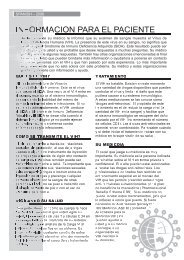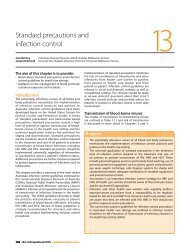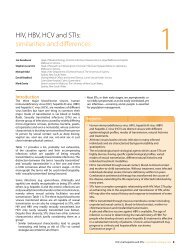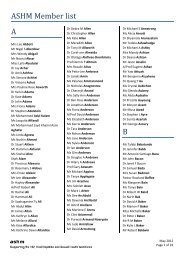B Positive – all you wanted to know about - ASHM
B Positive – all you wanted to know about - ASHM
B Positive – all you wanted to know about - ASHM
You also want an ePaper? Increase the reach of your titles
YUMPU automatically turns print PDFs into web optimized ePapers that Google loves.
7 Treatment of chronic hepatitis B virus infection<br />
a sm<strong>all</strong> but significant proportion<br />
(approximately 5%) of patients treated with<br />
ifn also achieves Hbsag seroconversion. this is<br />
seen particularly in those with genotype a, the<br />
most common genotype in caucasian patients.<br />
Loss of Hbsag is significantly less common with<br />
direct antiviral agents (see below).<br />
PeG-ifn also has a role in the treatment of<br />
Hbeag-negative patients. a sustained control<br />
of viral replication (< 2000 iu/mL) is seen in<br />
approximately 30% of patients six months<br />
after the completion of therapy. 9 the control of<br />
viral replication at these levels should reduce<br />
the progression <strong>to</strong> clinic<strong>all</strong>y significant liver<br />
disease.<br />
the main advantage of PeG-ifn is the fixed<br />
duration of therapy and the chance for Hbsag<br />
seroconversion. the main disadvantage is<br />
the side effect profile, predominantly fatigue,<br />
irritability and leukopenia. flares of viral<br />
hepatitis can result from the enhanced immune<br />
clearance. flares can be seen in 12%<strong>–</strong>18%<br />
of patients and can be severe in those with<br />
advanced underlying liver disease. 1 PeG-ifn is<br />
contraindicated in decompensated cirrhosis.<br />
the main concern when using PeG-ifn is the<br />
ongoing viral replication that persists at the<br />
completion of therapy in many patients. it<br />
is possible for patients who have ongoing,<br />
clinic<strong>all</strong>y significant viral replication after the<br />
completion of PeG-ifn therapy <strong>to</strong> receive oral<br />
antiviral therapy. However, this approach has<br />
not been validated in clinical trials. 1<br />
Lamivudine<br />
Lamivudine was the first antiviral agent<br />
available for treatment of HbV infection. it is<br />
an oral nucleoside analogue, well <strong>to</strong>lerated<br />
and without significant side effects. it induces<br />
profound inhibition of viral replication in<br />
almost <strong>all</strong> patients, which results in improved<br />
liver his<strong>to</strong>logy, improved liver function in<br />
decompensated disease and, in some studies,<br />
a reduction in the rate of Hcc in patients with<br />
advanced fibrosis. it may be taken with or<br />
without food, and is well <strong>to</strong>lerated, with a side<br />
effect profile similar <strong>to</strong> the placebo. 1<br />
60 b <strong>Positive</strong> <strong>–</strong> <strong>all</strong> <strong>you</strong> <strong>wanted</strong> <strong>to</strong> <strong>know</strong> <strong>about</strong> hepatitis b: a guide for primary care providers<br />
the endpoint of therapy for Hbeag-positive<br />
disease is Hbeag seroconversion with<br />
associated control of viral replication. Hbeag<br />
seroconversion only occurs in a minority of<br />
patients; this is more likely <strong>to</strong> occur in those<br />
with a markedly elevated aLt. seroconversion<br />
rates continue <strong>to</strong> increase the longer a patient<br />
remains on therapy (17% after one year of<br />
treatment, 27% after two years of treatment<br />
and 50% by year five of treatment). 10 therapy<br />
is indefinite if Hbeag seroconversion does not<br />
occur. therapy for Hbeag-negative infection<br />
is indefinite, as relapse after the cessation of<br />
therapy is almost universal. unfortunately,<br />
prolonged therapy with lamivudine is limited<br />
by the high rates of viral resistance, occurring<br />
in 14%<strong>–</strong>32% after one year of therapy and in<br />
60%<strong>–</strong>70% after five years of therapy. 11 When<br />
resistance develops, efficacy is lost and in some<br />
patients severe exacerbations of liver disease<br />
can occur. 1 as a consequence, lamivudine is no<br />
longer the best option for first-line therapy, now<br />
that other agents with an improved resistance<br />
profile are available.<br />
Entecavir<br />
entecavir is a purine-derived nucleoside<br />
analogue. it is highly effective at inhibiting viral<br />
replication, and early studies confirmed that<br />
this inhibition of viral replication was associated<br />
with improvements in liver his<strong>to</strong>logy. entecavir<br />
has few side effects, the most common being<br />
headache (2<strong>–</strong>4%) and fatigue (1<strong>–</strong>3%), although<br />
adverse events were equ<strong>all</strong>y seen in the<br />
lamivudine-treated group when the two agents<br />
were compared. 12 unlike other antiviral agents,<br />
entecavir must be taken on an empty s<strong>to</strong>mach,<br />
two hours before or after a meal.<br />
compared with lamivudine and adefovir,<br />
entecavir has the greatest potency (measured<br />
by the decrease in viral load from baseline) of<br />
the available direct antiviral agents, compared<br />
with lamivudine and adefovir. Hbeag rates of<br />
clearance are similar <strong>to</strong> those seen with other<br />
antiviral agents. importantly, entecavir has<br />
the lowest rate of resistance (less that 1% in<br />
nucleoside-naïve patients after one <strong>to</strong> two<br />
years). 1,13 from november 2006, the Pbs agreed<br />
<strong>to</strong> support the use of entecavir for treatment-<br />
naïve patients with HbV infection. entecavir has






